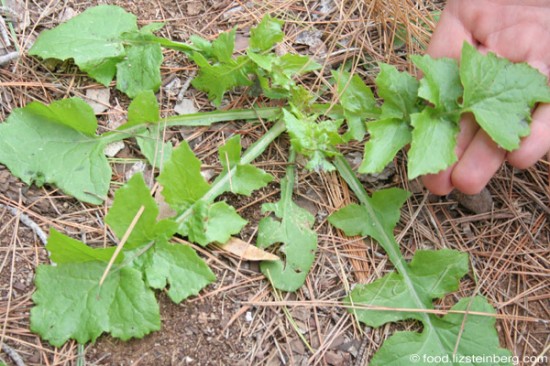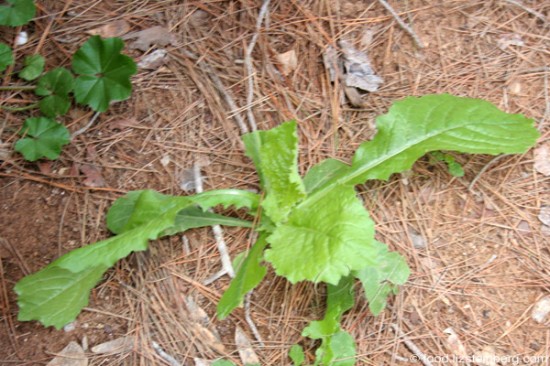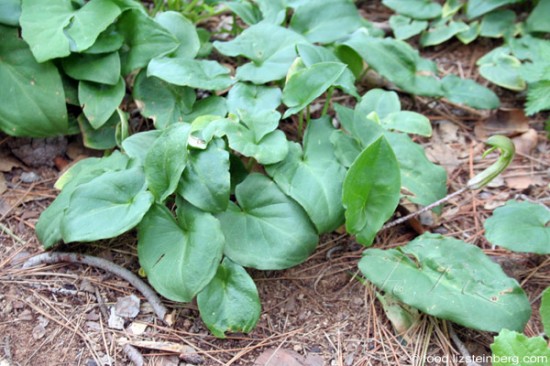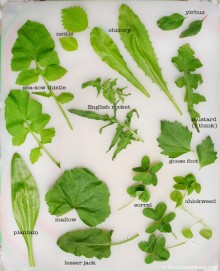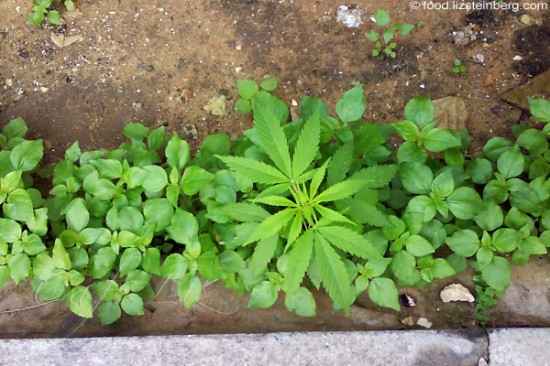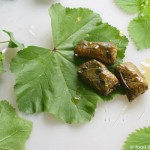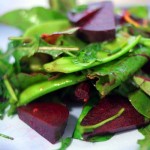Winter weekend weed walks

I attended two weed walks last week. Both had been delayed due to rain. Coincidence? Not at all.
We’ve had several years of drought, and the rain came late this year. But once it started, it didn’t stop. When the winter rains begin, the dusty earth quickly comes alive with fresh green growth. Flat brown yards and parking lots fill up with massive packs of mallow, and green shoots peek from between cracks in the pavement.
Many of the country’s wild plants are edible, and thus have played a role in regional culinary traditions. Over the past decades these traditions have been largely ignored, forgotten or shunted aside, whether due to ignorance or their association with poverty, as the familiar group of internationally-recognized vegetables dominate agriculture and markets.
Yet foraging is making somewhat of a comeback. In fact, you could even call it trendy in certain circles. For those looking for a greater connection to the land, to broaden their culinary horizons, to eat local and organic, it seems like a natural choice.
And fortunately for us city-dwellers, you don’t even have to go farther than the nearest yard. Many of the most popular plants to forage are ruderals, meaning they follow humans — they spring up in (man-made) empty lots, where they have no competition. Once you know what you’re looking for, the entire city starts to look like a huge salad. To prove this point to a friend, Eitan started nibbling straight off a mallow bush in her yard. OK, that was for shock value.
Weed walk #1
The first event was hosted by a group called Nature in the City — the Forum of Residents for Urban Nature and Environment in Tel Aviv-Jaffa. (Here’s their February newsletter, in Hebrew). They host periodic foraging mornings, and the event we attended was held in honor of the fact that city hall had stopped spraying herbicides in various open spaces, at their request. It had been less than six months, and the small lot where the event occurred was full of a wide variety of plants.
As the children in the group dashed about underfoot, mobbing mallows and eagerly pulling off leaves, us larger children followed along, took photos and stashed a few leaves for a salad later. Not surprisingly, when it comes to freshness and taste, you can’t beat a salad that was attached to a plant a few minutes earlier.
For safe foraging: Use books or a reliable source to learn to identify plants. We were told you won’t die from nibbling on a leaf from a weed, and that poisonous plants tend to taste and smell unappealing, but I prefer to be more cautious. Mushrooms and trees are more likely to be poisonous than weeds.
Respect nature: Don’t pick most of the leaves of any given plant, don’t pick seeds or flowers, and don’t uproot the plant.
Galit, one of the organizers, takes one child’s mallow as an example of what not to do:
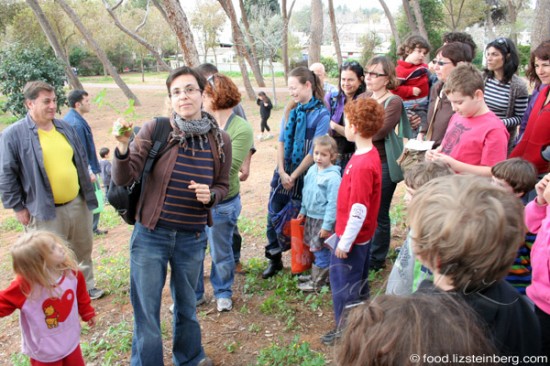
Lesser jack (in Hebrew, amikh kotzani — ×מיך ×§×•×¦× ×™), which resembles spinach:
London rocket (tudra sigit — תודרה סיגית), a spicy, horseradish-flavored plant often confused for mustard. Note the lacy, arugula-esque leaves:
Sea-sow thistle (maror haginot — מרור ×”×’×™× ×•×ª, yes, as in bitter herbs). Despite its name, it also is spinach-like and not bitter. Note that the serrated leaves have a fat, wide lobe at the end:
Chicory (olesh — עולש). The leaves are serrated and have a distinctive bitter flavor (center in photo). In a few months, the plant will have tall stalks with blue flowers. In the upper left corner is a small mallow (hubeza — חובזה or halamit — חלמית) plant:
Goose foot (kaf avaz — ×›×£ ×ווז). This is a relative of quinoa and I think it also has a spinach-like taste — meaning, it doesn’t have a distinctive flavor I can identify as bitter or spicy. It gets its name from the shape of its leaves. Once I learned to identify it, suddenly I started seeing it everywhere.
Nettle (sirpad — סרפד). Known for its sting, which is easily neutralized: Being careful not to brush your hand against the top part of the leaf or the stem, reach underneath each leaf and pinch it in half. There are no bristles on the underside, and once you press the sides of the leaf together and crush the bristles, the sting will be gone. Alternately, heat it.
On the left, nettle; on the right, goose foot:
Yirbuz (ירבוז), a member of the amarinth family. I’m not sure which variety we found, but it might be called pigweed in English:
Arum (luf — לוף) is an interesting plant, because it’s both poisonous but considered a delicacy. Raw, the plant is poisonous and you can tell because it makes your mouth tingle and go numb (it also can make your throat swell and suffocate you). But once it’s cooked for hours in lots of acid like lemon juice, it’s considered a delicacy. Abbie has two interesting posts about her fraught relationship with the plant, whose name also happens to mean “spam” in Hebrew. It’s quite an attractive plant, and I’m content just looking at it.
After the walk, the kids made pesto and salad from the fresh leaves:
A few other plants we found: cow thistle (gedilan — גדילן), eat young leaves or remove the thorny edges; tournefort mustard (kruv hahof — כרוב החוף), whose seeds are edible; shepherds purse (yilkut haroim — ילקוט הרועי×); crown daisy (haratzit — חרצית), whose stems are edible; and spring groundsel (savion — סביון), which can be used for tea.
Here’s a “summary” of various leaves:
Weed walk #2
The following Friday, I attended another weed walk with the lovely bloggers in and around Sarah‘s yard. We picked lots of nettles, mallow and chickweed, as well as some edible flowers for a salad.
Sarah and Ariella nibble some sorrel:
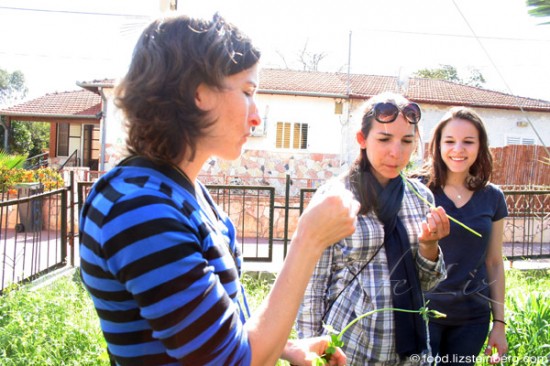
Miriam had brought a pita dough, a soft mix of flour and water with a bit of yeast, left to rise slowly overnight. We pulled off balls and flattened them with our hands, baking them on a saj — a large metal disc — which Sarah had placed over her gas stove top, instead of over the traditional fire outside.
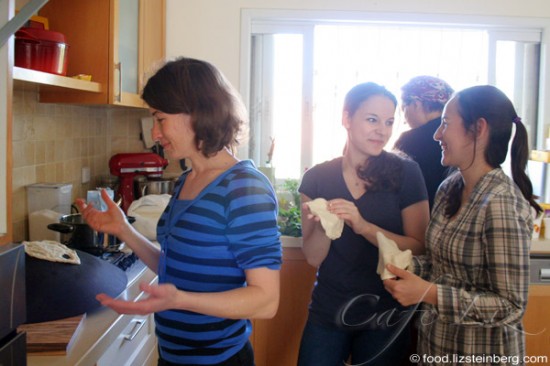
Miriam sauteed the nettles and mallow with some chopped onion, and we awkwardly filled our lumpy pitas with cooked greens and cheese.

The wonderful thing about food is that it can taste great even if it doesn’t look picture perfect.

The fruit salad, however, looked lovely with edible pansies, alyssums and begonias.
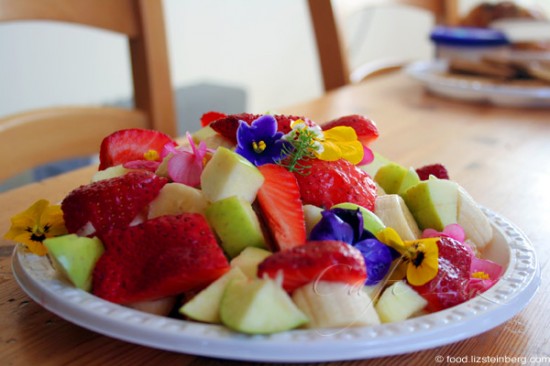
Posts about our foraging lunch by Miriam, Ariella and Yael.
Another kind of weed
A few days later, I was walking along King George, peeking into yards and practicing identifying plants, when I found the following …. weed:
I did a double-take; this was growing literally a meter from the sidewalk, in front of the busy Dizengoff Center mall. As friends of mine confirmed, marijuana takes a lot of care and doesn’t just grow on its own. However, it may not actually be marijuana: A reliable source told me it could be ditch weed, a less contentious member of the hemp family.
More on wild plants
My post from last year on finding foraged plants in markets, including some protected (and thus illegally foraged) plants.




